Two Popular, Affordable EVs Face Off
The Chevy Bolt and Nissan Leaf are the two most popular BEVs that can be readily bought today.
Clean Fleet Report has written extensively about these two cars, but have not compared them head-to-head. We wanted to look at the value of the two vehicles beyond the MSRP and provide additional data points to compare them. The categories that we have chosen provide clear-cut measurements and are based on our impressions from driving the cars, as well as available information from GM and Nissan.
Both the Leaf and the Bolt have several trim levels and option packages. Since we are not comparing price but rather features, we will be comparing the top trim levels with all of the options that are available.
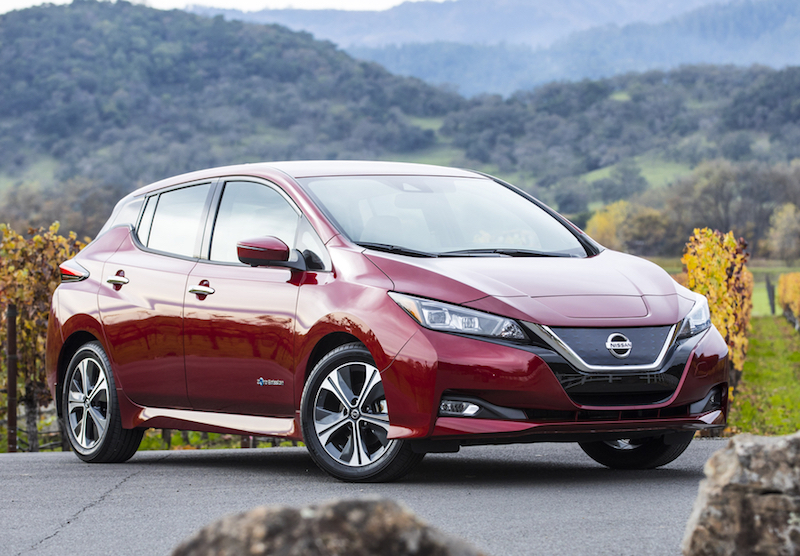
One question our readers may ask is: “Where is the Tesla Model 3?” While the Model 3 is a fine automobile, it isn’t included simply because unless you made a reservation years ago to buy one, it isn’t readily available for purchase today. The Bolt and Leaf, on the other hand, are available in all 50 states. When Tesla has cleared its backlog and has the Model 3 for purchase, we will add them to an update.
Here is how the Bolt and the Leaf compare to each other in these main categories.
Size
Nissan Leaf
EPA size class: Midsize car
Wheelbase: 106.3 in.
Track: front/rear: 60.6/61.2
Overall length: 176.4 in.
Overall width: 70.6 in
Overall height: 61.4 in.
Coefficient of drag: 0.280
Weight: 3433 lbs.
Chevy Bolt
EPA size Class: Small Station Wagon
Wheelbase: 102.4 in.
Track: front/rear: 59.1/59.1 in
Overall length: 164.0 in.
Overall width: 69.5 in
Overall height: 62.8 in.
Coefficient of drag: 0.308
Weight: 3563 lbs.
The Bolt is a shorter, taller and narrower car than the Leaf. Because of the Bolt’s tall, narrow, squat shape, it is also less aerodynamic than the Leaf. The Bolt is also heavier mainly because of its battery size. The Leaf longer wheelbase makes for a better ride.
Winner: Nissan Leaf
Interior size comfort and seating
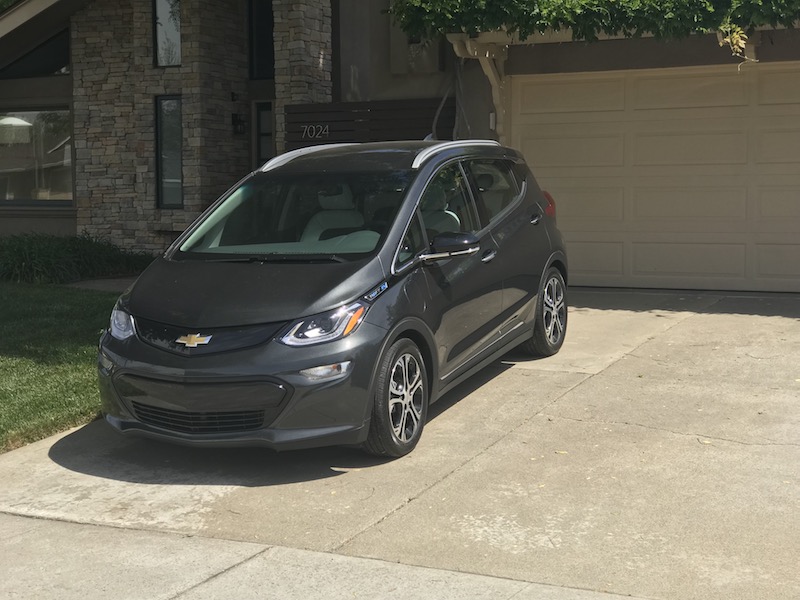
Nissan Leaf
Seating capacity: 5 passengers
Front Headroom: 41.2 in.
Front Legroom: 42.1 in.
Hip Room: 51.7 in.
Shoulder Room: 54.3 in.
Rear Head room: 37.3
Rear Leg room: 33.5 in.
Rear Hip room: 50.0 in.
Rear Shoulder room: 52.5 in.
Chevy Bolt
Seating capacity: 5 passengers
Front Headroom: 39.7 in.
Front Legroom: 41.6 in.
Front Hip Room: 51.6 in.
Front Shoulder Room: 54.6 in.
Rear Head room: 37.9
Rear Leg room: 36.5 in.
Rear Hip room: 50.8 in.
Rear Shoulder room: 52.8 in.
The Leaf and the Bolt are very close in interior room, with the Bolt having a slight edge in rear seat room. The way that the Bolt achieves this is by having a very thin front seat back and narrow hard seat bottom. The rear seats are also very upright with thin seat bottoms. Combined with a very upright front seating position, this has been criticized by many reviewers.
The Leaf’s slightly larger interior space has been used to accommodate larger more comfortable front and rear seats. These “Zero Gravity” seats are ergonomically designed to place minimum stress on the human body to optimize comfort on long drives.
Winner: Nissan LEAF
Cargo Volume
Nissan Leaf
2nd Row upright: 23.6 ft3
2nd Row folded: 30.0 ft3
Total Interior volume: 116.0 ft3

Chevy Bolt
2nd Row upright: 16.9 ft3
2nd Row folded: 56.6 ft3*
Total Interior volume: 111.3ft3
On the surface, it looks like the Leaf has a larger cargo capacity because its total interior volume is over 5 ft3 larger than the Bolt. With the seats up, the Leaf is the clear winner, but GM’s published specifications state that the Bolt has more cargo volume by 26 ft3 with its rear seats down than the Leaf. We have reached out to GM to clarify how they came up with their 2nd row seats down number.
Winner: Tie, Rear seats up: Nissan Leaf, Rear seats down: Chevy Bolt
Infotainment
Nissan Leaf
7.0-inch center touch screen, 7.5-inch driver digital information screen
AM/FM/Sirius XM, USB & Bluetooth streaming input for media player/ smartphone. HD radio, Nissan Connect telematics with remote connection to vehicle including battery monitoring, remote start charging and HVAC cabin pre-conditioning. Hands-free phone and text messaging. Nissan Connect with navigation with voice guidance. Apple CarPlay and Android Auto. Bose premium audio with seven speakers.
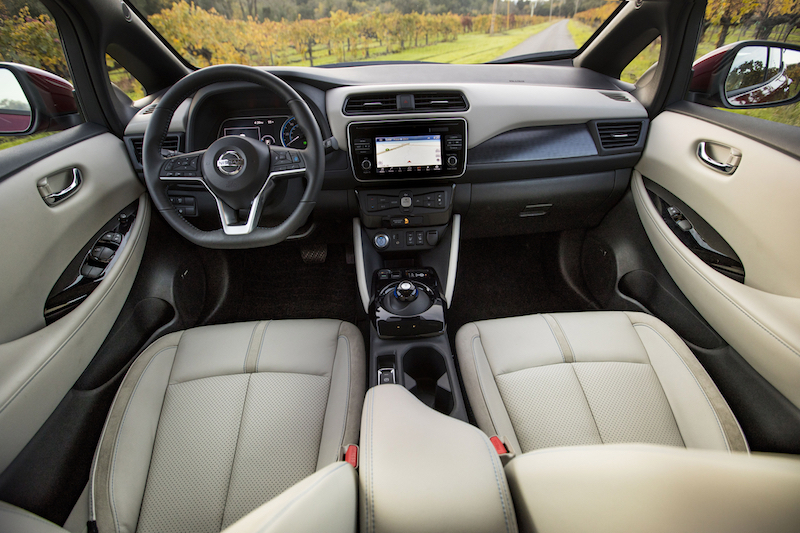
Chevy Bolt
10.2-inch center touch screen, 8.0-inch driver digital information screen
AM/FM/Sirius XM, USB & Bluetooth streaming input for media player / Smartphone. OnStar, Wi-Fi hotspot, remote start charging and HVAC cabin pre-conditioning. OnStar navigation with voice guidance. Apple CarPlay and Android Auto. Bose premium audio with seven speakers.
Both cars have full-featured infotainment systems, the Bolt has a larger center screen that seems huge set in the cramped dashboard. The Bolt and Leaf have different user interfaces; it’s subjective which one is better. Both cars use a combination touch screen buttons or conventional buttons to control different aspects of the systems and have good smartphone integration that allows remote access to the vehicle.
Winner: Tie, both vehicles have similar infotainment offerings.
HVAC systems
Nissan Leaf
Automatic HVAC system with manual overrides of all functions. Hybrid heat pump system with an electric air conditioner compressor assist except for the entry level model which uses an electric resistive heater.
Chevy Bolt
Automatic HVAC system with manual overrides of all functions. Heating is done with an electric resistive heater and electric air conditioner compressor.
By utilizing a heat pump rather than resistance heating (think of a home plug-in electric space heater that uses electricity to heat up wires which air is blown over to heat the space) the Leaf is more efficient in its use of the battery, which translates into more range from less battery. The downside of the heat pump is that the colder it is outside, the less efficient it is. But for average weather, the Heat Pump scheme is superior to a resistive heater.
Winner: Nissan Leaf
Acceleration and Top Speed
Nissan Leaf
147 Horsepower/236 pound-feet of torque
0-60 MPH: 7.5 sec.
Top Speed: 92 MPH
Chevy Bolt
200 Horsepower/266 pound-feet of torque
0-60 MPH: 6.5 sec.
Top Speed: 93 MPH
The Chevy Bolt is the winner here by a full second in the quarter mile and a one mph higher top end. With the Leaf e+ on the horizon with a more powerful motor, we will have to retest this fall to see if the Bolt still remains on top.
Winner: Chevy Bolt
Ride and chassis control
Nissan Leaf
Front suspension: MacPherson strut with coil springs and front stabilizer bar
Rear Suspension: Torsion beam with coil springs and integrated stabilizer bar
Electronic torque vectoring and ride control
Vehicle Dynamic Control
Four-wheel power assisted disc brakes
Four-wheel anti-lock braking (ABS)
Electronic brake force assist
Electric power steering
Cooperative regenerative brakes
Chevy Bolt
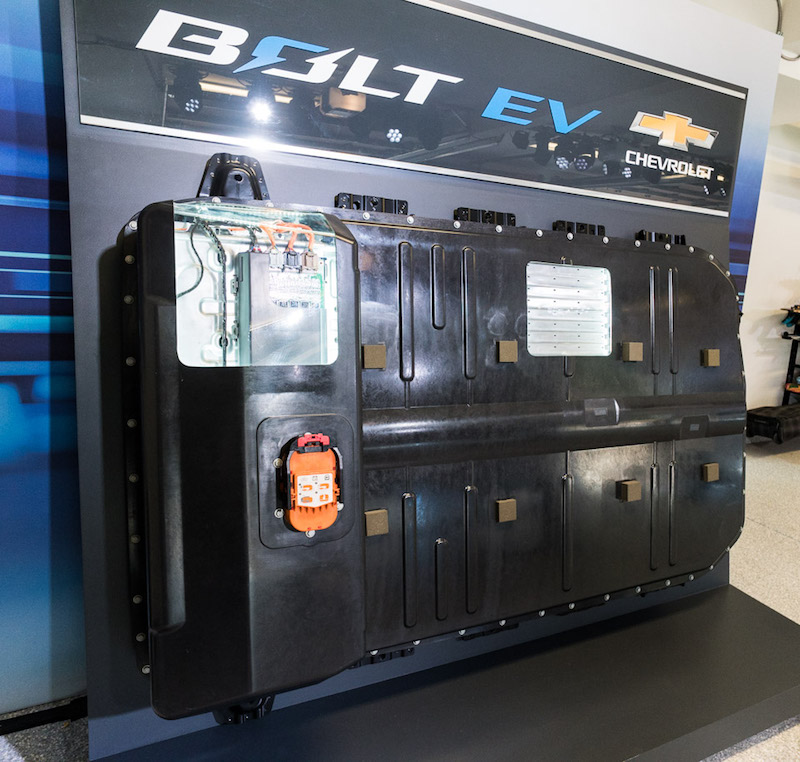
Front suspension: MacPherson strut with coil springs and front stabilizer bar
Rear Suspension: Torsion beam with coil springs and integrated stabilizer bar
Four-wheel power assisted disc brakes
Four-wheel anti-lock braking (ABS)
Electronic brake force assist
Electric power steering
Cooperative regenerative brakes
On the surface the two cars look pretty evenly matched, and for smooth, straight roads that is true. But the Bolt has two short comings that give it an inferior ride on uneven roads. The first is the Bolt’s wheelbase. Its short wheelbase combined with springs that are optimized for a soft ride on smooth roads is tough on the Bolt when driven choppy roads that are full of ruts or inconsistent surfaces. Because of its short wheelbase it gets in a rut of the peaks and valleys of the road. This type of road surface sets up a nasty fore and aft pitching motion. In the early days of the Porsche 911, it also had a similar flaw, which was rectified by increasing the wheelbase. It is hopeful that future versions of the Bolt will have a stretched wheelbase.
The Leaf does not suffer from these same road manners on choppy roads for two reasons. The Leaf has a longer wheelbase that in most conditions is not susceptible to the harmonics of a choppy roadway. The second is the Leaf’s active electronic chassis control. Nissan calls it Vehicle Dynamic Control; it consists of the motor control electronics making small very quick changes to the electric motor’s torque and the electronic braking systems that apply small amounts of braking to the Leaf, which dampens the pitching and body motion of the vehicle. All of this happens automatically and with the adjustments made hundreds of times a second. This gives the Leaf a smooth ride no matter what the road surface.
Both cars are great on smooth even roads, but the Leaf ride is superior on more challenging real-world roads.
Winner: Nissan Leaf
Range per charge
Nissan Leaf
EPA-estimated range – 151 miles
Real-world mileage up to 165 miles
Chevy Bolt
EPA-estimated – 238 miles
Real-world mileage up to 250 miles
At this time, the reigning winner in the range wars is the Bolt. Lots is happening in 2018 from Nissan and other manufacturers that will call for a rematch later in the year.
Winner: Chevy Bolt
Powertrain and Battery
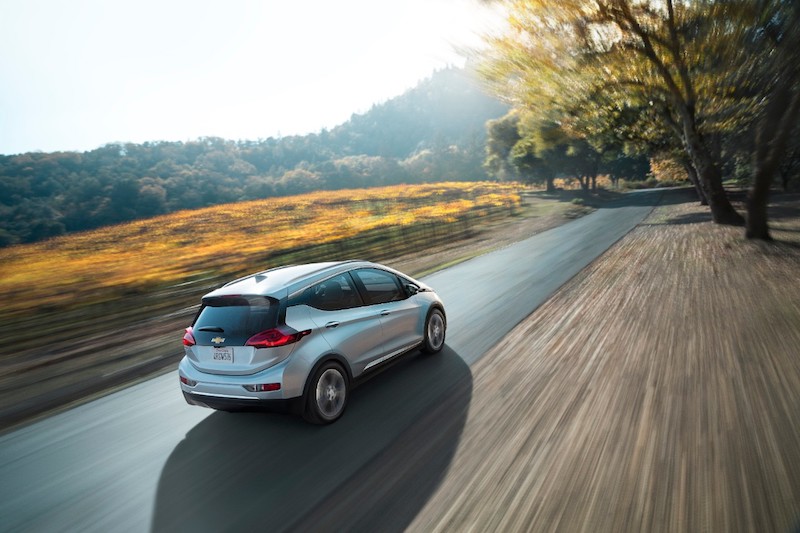
Nissan Leaf
110-kW AC synchronous electric motor
147 horsepower
236 foot-pounds of torque
Front-wheel drive
Single-speed transmission
40 kWh laminated lithium-ion battery, 192 cells
Chevy Bolt
150 kW permanent magnetic electric motor
200 horsepower
266 foot-pounds of torque
Front-wheel drive
Single-speed transmission
60 kWh lithium-ion battery, 288 cells
At this time the reigning winner in the battery and power wars is the Bolt. Both the Bolt and Lead have a similar battery energy density, but the Bolt wins hands down with its leading 60 kWh battery and a more powerful motor vs. the Leaf’s 40 kWh battery and less-powerful motor. This leadership may be short lived as the evolution to 60 kWh and larger batteries is on every BEV manufacturer’s roadmap. There will be lots happening in 2018 from Nissan and other manufacturers that will call for a rematch later in the year.
Winner: Chevy Bolt
Charging and network compatibility
Nissan Leaf
6.6 kW onboard charger L2 compatibility
Charging time: @220V ~ 7.5 hours
CHAdeMO L3 quick charger compatibility
Charging time: 40 minutes for 80% or 120 miles of range
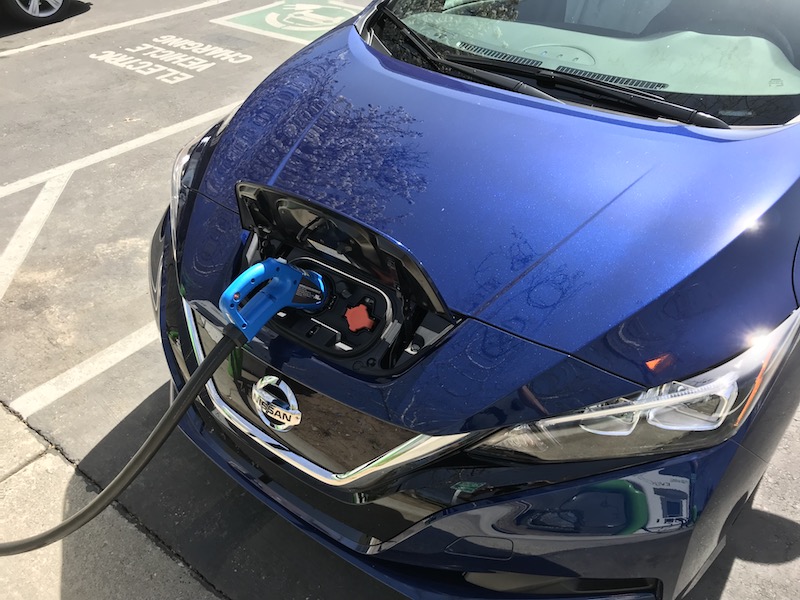
Chevy Bolt
7.2 kW onboard charger L2 compatibility
Charging time: @220v ~ 9.75 hours
SAE Combined Charging System (CCS) L3 quick charger compatibility
Charging time: 30 minutes for 40% or 90 miles of range
Despite the Bolt having a more powerful onboard charger, it still takes longer to completely recharge its battery than the Leaf simply because it has a larger battery and the Bolt’s very conservative recharging throttling. The difference is small, with the Bolt adding about 6.15 kW per hour and the Leaf adding 5.33 kW per hour. Of course, these are calculated numbers and do not take into consideration the temperature of the battery, etc. For fast charging, there is currently a shakeout happening with the fast charging standards. The SAE CCS standard is gaining steam over the CHAdeMO standard. For now, most new public quick charging stations are providing both types of quick charge compatibility, but as charging speeds and power continue to increase, especially in the CCS arena, one has to wonder if CHAdeMO’s days are numbered.
Winner: Tie, both vehicles have similar charging capabilities today, and support for both CHAdeMO and CCS is still there, but it is unclear what the CHAdeMO standard’s future will be.
Warranty
Nissan Leaf
Basic Vehicle Warranty: 36 months/36,000 miles
Corrosion Coverage: 60 months/unlimited miles
Powertrain Coverage: 60 months/60,000 miles
EV System Coverage: 60 Months/60,000 miles
Chevy Bolt
Basic Warranty: 36 months/36,000 miles
Corrosion Coverage: 72 months/100,000 miles
Powertrain Coverage: 60 months/60,000 miles
EV System Coverage: 96 Months/100,000 miles
For the usual vehicle warranty, the Bolt has a longer coverage for EV systems. The corrosion warranties are essentially a wash.
Winner: Tie
Battery Warranty
Nissan Leaf
Lithium-Ion Battery Coverage: 96 months/100,000 miles
Lithium-Ion Battery Capacity Coverage: 96 months/100,000 Miles (70% capacity remaining)
Chevy Bolt
Lithium-Ion Battery Coverage: 96 months/100,000 miles
Lithium-Ion Battery Capacity Coverage: 96 months/100,000 miles (60% capacity remaining)
Both cars have similar battery warranties, but the Leaf’s capacity warranty kicks in at a lower level of degradation than the Bolt.
Winner: Tie
EPA efficiency
Nissan Leaf
MPGe: 125 city/100 highway/112 combined
Chevy Bolt
MPGe: 128 city/110 highway/119 combined
Winner: Chevy Bolt
Safety Technology
Nissan Leaf
Passenger restraint systems: Dual-stage front airbags, front seat side-impact airbags, and front and rear curtain side-impact airbags. Front and rear three-point seatbelts. LATCH child safety system.
Active safety, security and driving-aid systems: Vehicle immobilizer, vehicle security, automatic emergency braking (AEB), automatic emergency braking with pedestrian detection, ProPilot Assist, blind spot warning (BSW), rear cross-traffic alert (RCTA), Intelligent Driver Alertness (I-DA), Intelligent Lane Intervention (I-LI) with haptic feedback, anti-lock braking system (ABS), Vehicle Dynamic Control (VDC), traction control system (TCS), tire pressure monitoring system (TPMS), Intelligent Around View Monitor (I-AVM), Intelligent Cruise Control (ICC), ePedal (advanced 1-pedal operation), hill start assist (HSA), electronic brake force distribution (EBD), high beam assist (HBA), rear parking assist (RPA).
Chevy Bolt
Passenger restraint systems: Dual-stage front airbags, front seat side-impact airbags, and front and rear curtain side-impact airbags. Front and rear three-point seatbelts. LATCH child safety system.
Active safety, security and driving-aid systems: Vehicle Immobilizer, vehicle security, low-speed forward automatic braking, front pedestrian braking, side blind zone alert, lane keep assist, anti-lock braking, forward collision alert, rear cross-traffic alert, traction control, tire pressure monitoring system, Surround Vision, regenerative braking one-pedal driving, IntelliBeam headlamps.
The Leaf has the advantage when it comes to safety and Level 2 autonomous safety technology. Pro-Pilot Assist bundles all of the Leafs safety features into one system, from intelligent cruise control to vehicle dynamic control. Many of the systems that the Leaf has are also included with the Bolt, but their integration seems to be haphazard or lacking.
For example, the Bolt has an adjustable forward collision alert, which only works at low speeds. It simply beeps at you and flashes some red lights on the dashboard. The Leaf, on the other hand, takes that basic system and adds speed and distance control that slows or stops the vehicle before a collision occurs. The Bolt also lacks adaptive cruise control, which is strange in this day and age.
The Bolt can use its regenerative braking to slow or stop the car, but it requires intervention from the driver to make it work satisfactorily. The Leaf has ePedal that uses both the regenerative braking as well as the friction brakes to brake predictable stops and makes one pedal driving very easy and intuitive.
For these important and critical safety systems that are the first steps to fully autonomous driving, the Leaf leaves the Bolt in the dust.
Winner: Nissan Leaf.
Is there an overall winner? It depends on what your priorities are. If the longest range available and strong acceleration is the top priority, then the Bolt will probably suit your needs. If ride quality, comfort, safety, size, and advanced driving features are important, then the Leaf does much better in these areas than the Bolt. If you are looking for a quality battery electric five-door hatchback that will serve you well, both of these cars are worth your time to investigate. Each has its strong points, but the decision is up to you which will work best.
Related Stories You Might Enjoy: More Leaf & Bolt Reviews
Road Trip: 2018 Nissan Leaf
Interview: Chevrolet Bolt at One Year
Flash Drive: 2018 Nissan Leaf (Steve’s view)
Road Test: 2017 Chevrolet Bolt
Flash Drive: 2018 Nissan Leaf (John’s view)
Personal: One Year with My Chevrolet Bolt EV
Disclosure:
Clean Fleet Report is loaned free test vehicles from automakers to evaluate, typically for a week at a time. Our road tests are based on this one-week drive of a new vehicle. Because of this we don’t address issues such as long-term reliability or total cost of ownership. In addition, we are often invited to manufacturer events highlighting new vehicles or technology. As part of these events we may be offered free transportation, lodging or meals. We do our best to present our unvarnished evaluations of vehicles and news irrespective of these inducements.
Our focus is on vehicles that offer the best fuel economy in their class, which leads us to emphasize electric cars, plug-in hybrids, hybrids and diesels. We also feature those efficient gas-powered vehicles that are among the top mpg vehicles in their class. In addition, we aim to offer reviews and news on advanced technology and the alternative fuel vehicle market. We welcome any feedback from vehicle owners and are dedicated to providing a forum for alternative viewpoints. Please let us know your views at publisher@cleanfleetreport.com.

2 thoughts on “Comparison Test: 2018 Chevy Bolt & 2018 Nissan Leaf”